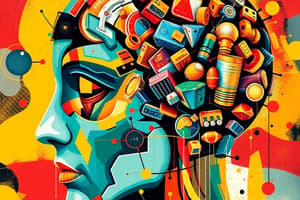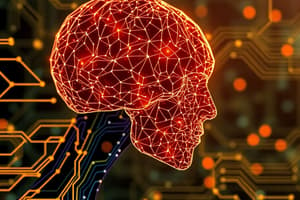Podcast
Questions and Answers
Which type of AI is designed to perform any intellectual task that a human being can?
Which type of AI is designed to perform any intellectual task that a human being can?
- General AI (correct)
- Artificial Superintelligence
- Narrow AI
- Weak AI
In the context of machine learning, what is the primary characteristic of unsupervised learning?
In the context of machine learning, what is the primary characteristic of unsupervised learning?
- Explicit programming for specific tasks
- Discovering patterns in unlabeled data (correct)
- Training on labeled data for predictions
- Maximizing rewards through environmental interactions
Which of the following deep learning architectures is most commonly used for image and video recognition tasks?
Which of the following deep learning architectures is most commonly used for image and video recognition tasks?
- Convolutional Neural Networks (CNNs) (correct)
- Recurrent Neural Networks (RNNs)
- Generative Adversarial Networks (GANs)
- Long Short-Term Memory networks (LSTMs)
Which of the following is a core application of Natural Language Processing (NLP)?
Which of the following is a core application of Natural Language Processing (NLP)?
How can AI contribute to personalized treatment plans?
How can AI contribute to personalized treatment plans?
In the finance industry, what is one way AI is utilized?
In the finance industry, what is one way AI is utilized?
What is a primary way AI contributes to the transportation industry?
What is a primary way AI contributes to the transportation industry?
In education, how can AI personalize learning experiences?
In education, how can AI personalize learning experiences?
Which of the following describes the role of AI in manufacturing?
Which of the following describes the role of AI in manufacturing?
What is one way AI enhances customer service?
What is one way AI enhances customer service?
How is AI used to personalize entertainment experiences?
How is AI used to personalize entertainment experiences?
Which of the following is a major benefit of AI?
Which of the following is a major benefit of AI?
What is a significant ethical challenge posed by AI regarding data?
What is a significant ethical challenge posed by AI regarding data?
What is a key ethical consideration related to AI?
What is a key ethical consideration related to AI?
What does Explainable AI (XAI) aim to achieve?
What does Explainable AI (XAI) aim to achieve?
What is the core concept behind Federated Learning?
What is the core concept behind Federated Learning?
What is the primary goal of AI ethics and governance?
What is the primary goal of AI ethics and governance?
What does the concept of Generative AI involve?
What does the concept of Generative AI involve?
What is a potential consequence of lacking transparency in AI decision-making processes?
What is a potential consequence of lacking transparency in AI decision-making processes?
In reinforcement learning, what is the primary objective of an agent?
In reinforcement learning, what is the primary objective of an agent?
Flashcards
Artificial Intelligence (AI)
Artificial Intelligence (AI)
The simulation of human intelligence in machines programmed to think and act like humans, performing tasks like learning and problem-solving.
Narrow (Weak) AI
Narrow (Weak) AI
AI designed for a specific task, like playing chess. Lacks broad, general intelligence.
General (Strong) AI
General (Strong) AI
AI with human-level intelligence, capable of performing any intellectual task a human can.
Artificial Superintelligence
Artificial Superintelligence
Signup and view all the flashcards
Machine Learning (ML)
Machine Learning (ML)
Signup and view all the flashcards
Deep Learning (DL)
Deep Learning (DL)
Signup and view all the flashcards
Neural Networks
Neural Networks
Signup and view all the flashcards
Natural Language Processing (NLP)
Natural Language Processing (NLP)
Signup and view all the flashcards
Supervised Learning
Supervised Learning
Signup and view all the flashcards
Unsupervised Learning
Unsupervised Learning
Signup and view all the flashcards
Reinforcement Learning
Reinforcement Learning
Signup and view all the flashcards
Feature Learning
Feature Learning
Signup and view all the flashcards
Convolutional Neural Networks (CNNs)
Convolutional Neural Networks (CNNs)
Signup and view all the flashcards
Recurrent Neural Networks (RNNs)
Recurrent Neural Networks (RNNs)
Signup and view all the flashcards
NLP Applications
NLP Applications
Signup and view all the flashcards
AI in Fraud Detection
AI in Fraud Detection
Signup and view all the flashcards
Algorithmic Trading
Algorithmic Trading
Signup and view all the flashcards
AI in Healthcare
AI in Healthcare
Signup and view all the flashcards
AI in Self-Driving Cars
AI in Self-Driving Cars
Signup and view all the flashcards
Automation
Automation
Signup and view all the flashcards
Study Notes
- Artificial Intelligence (AI) refers to the simulation of human intelligence in machines that are programmed to think and act like humans
- It involves the development of computer systems capable of performing tasks that typically require human intelligence, such as learning, problem-solving, decision-making, and perception
Types of AI
- Narrow or Weak AI: Designed for a specific task, like playing chess or spam filtering
- General or Strong AI: Possesses human-level intelligence and can perform any intellectual task that a human being can
- Artificial Superintelligence: Surpasses human intelligence in all aspects
Key Concepts in AI
- Machine Learning (ML): A subset of AI that enables systems to learn from data without being explicitly programmed
- Deep Learning (DL): A subset of ML that uses artificial neural networks with multiple layers to analyze data
- Neural Networks: Computing systems inspired by the biological neural networks that constitute animal brains
- Natural Language Processing (NLP): Focuses on enabling computers to understand, interpret, and generate human language
Machine Learning Explained
- Supervised Learning: Training a model on labeled data to make predictions or classifications
- Unsupervised Learning: Discovering patterns and relationships in unlabeled data
- Reinforcement Learning: Training an agent to make decisions in an environment to maximize a reward
Deep Learning Explained
- Deep learning models can automatically learn features from raw data, reducing the need for manual feature engineering
- Convolutional Neural Networks (CNNs) are commonly used for image and video recognition
- Recurrent Neural Networks (RNNs) are designed to handle sequential data, such as text and speech
Natural Language Processing Explained
- NLP tasks include sentiment analysis, machine translation, and chatbots
- Techniques involve statistical methods, machine learning, and deep learning to process and understand text and speech data
Applications of AI
- Healthcare: AI assists in diagnosis, drug discovery, and personalized treatment
- Finance: AI is used for fraud detection, algorithmic trading, and risk management
- Transportation: Self-driving cars and drone delivery systems
- Education: Personalized learning and automated grading
- Manufacturing: Robotics and predictive maintenance
- Customer Service: Chatbots and virtual assistants
- Entertainment: Content recommendation and game playing
AI in Healthcare
- AI algorithms can analyze medical images to detect diseases like cancer
- AI can help predict patient outcomes and personalize treatment plans
- роботизированная хирургия is becoming increasingly popular
AI in Finance
- AI algorithms can detect fraudulent transactions in real-time
- Algorithmic trading uses AI to make trading decisions based on market data
- AI can assess credit risk and help automate loan approvals
AI in Transportation
- Self-driving cars use AI to perceive their surroundings and make driving decisions
- AI can optimize traffic flow and reduce congestion
- Drones can be used for delivery of goods and surveillance
AI in Education
- AI can personalize learning experiences based on student needs
- Automated grading can save teachers time and provide students with immediate feedback
- AI tutors can provide students with additional support
AI in Manufacturing
- Robots can perform repetitive and dangerous tasks
- Predictive maintenance can help prevent equipment failures
- AI can optimize production processes and improve efficiency
AI in Customer Service
- Chatbots can answer customer questions and resolve issues
- Virtual assistants can provide personalized support
- AI can analyze customer data to improve customer satisfaction
AI in Entertainment
- AI algorithms can recommend movies, music, and books
- AI can generate realistic characters and environments for video games
- AI can create personalized playlists and radio stations
Benefits of AI
- Automation: AI can automate repetitive tasks, freeing up humans for more creative work
- Efficiency: AI can improve efficiency and productivity in various industries
- Accuracy: AI can perform tasks with greater accuracy than humans in some cases
- Personalization: AI can personalize experiences and products to meet individual needs
- Decision-making: AI can provide insights and support decision-making
- Problem-solving: AI can solve complex problems that are difficult for humans to solve
Challenges of AI
- Bias: AI algorithms can perpetuate biases present in the data they are trained on
- Job displacement: AI can automate tasks currently performed by humans, leading to job losses
- Ethical considerations: AI raises ethical questions about privacy, security, and autonomy
- Lack of transparency: The decision-making processes of some AI algorithms can be difficult to understand
- Data requirements: AI algorithms require large amounts of data to train effectively
- Security risks: AI systems can be vulnerable to hacking and misuse
Ethical Considerations in AI
- Fairness: Ensuring that AI systems do not discriminate against certain groups of people
- Transparency: Making the decision-making processes of AI systems understandable
- Accountability: Holding individuals and organizations accountable for the actions of AI systems
- Privacy: Protecting individuals' privacy in the age of AI
- Security: Protecting AI systems from hacking and misuse
Future Trends in AI
- Explainable AI (XAI): Making AI systems more transparent and understandable
- Federated Learning: Training AI models on decentralized data sources
- Quantum AI: Using quantum computers to accelerate AI research
- Edge AI: Processing AI algorithms on edge devices, such as smartphones and IoT devices
- AI Ethics and Governance: Developing ethical guidelines and regulations for AI
- Human-AI Collaboration: Combining human and AI capabilities to solve problems
- Generative AI: Creating new content, such as images, music, and text, using AI
Studying That Suits You
Use AI to generate personalized quizzes and flashcards to suit your learning preferences.




